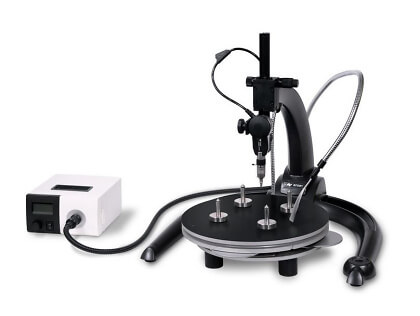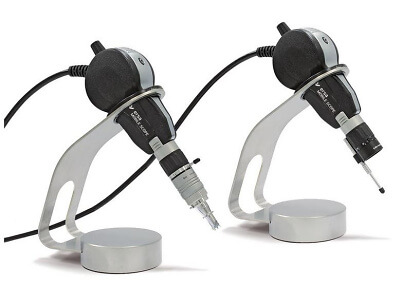Ersa rework systems and inspection systems
Ersa Rework Systems
Over the past two decades, rework and repair of electronic assemblies has been one of the most exciting and challenging topics in the industry. The increasing complexity of PCBs and assemblies posed additional challenges for rework professionals and their tools. Application-oriented, innovative solutions are also the key to success in this environment.
Ersa took up the rework challenge 20 years ago with the introduction of the first patented medium wave infrared rework system.
With more than 6,000 systems, from smaller workstation solutions to semi-automatic machines, we can now boast an installed equipment base that is unparalleled worldwide.
Ersa rework systems are without doubt the undisputed leader when it comes to the widest range of rework applications.
From the smallest 01005 component to large connectors, from SMT flip chips to THT pin grid arrays, from BGAs on flex circuit to multilayer BGAs and from shielding sheets to plastic processor sockets: Ersa Rework technology can handle it all.
As one of the undisputed market leaders in rework technology, Ersa's complete product range in this area is presented.
You can find more information about Ersa rework systems in our Online Shop or in our section Downloads.
HR 500
The Ersa HR 500 Hybrid Rework System is the first choice for all common rework tasks on medium-sized SMD components. The system is suitable for desoldering, placing and soldering PLCC, QFP and BGA components as well as for MLF components or two-pole elements up to an edge length of 1 x 1 mm.
Like all Ersa Hybrid Rework Systems, the HR 500 is equipped with a powerful hybrid top heater and highly dynamic infrared heating elements in the bottom heater (in two switchable zones).
The component is aligned using fine drives and high-resolution camera images from the vision box. The component is set down with almost no force by means of a stepper motor with fine cut-off. Overall, the device convinces with its intuitive operation and flexibility of use.
The HR 500 is prepared to accommodate an Ersa Dip & Print frame, component printing with solder paste is carried out externally at the Ersa Dip & Print station; the dip-in of a component into a flux depot is motorised. For process monitoring and documentation, the unit can optionally be equipped with a powerful reflow process camera with LED illumination.
HR 550
The Ersa Hybrid Rework System HR 550 is aimed at all users who place the highest demands on precision and safety when reworking electronic assemblies.
The HR 550 has a 1,500 W hybrid high-performance heating element with which SMT components up to a size of 70 x 70 mm can be soldered in and out. The 2,400 W infrared underheating in three zones ensures homogeneous heating of the entire assembly.
Non-contact and contacting temperature detection on the component as well as optimised process control ensure ideal desoldering and soldering processes. Component removal and placement is carried out via a high-precision vacuum pipette integrated in the heating head. The exchangeable heating head and the vacuum pipette are each controlled by a stepper motor. An integrated force sensor detects the contact to the component and the PCB.
Particularly pleasing for the user are the ergonomically favourable arrangement of the operating elements and the computer-aided component alignment using high-contrast, high-resolution camera images.
HR 550 XL
The Hybrid Rework System HR 550 XL serves all users who place the highest demands on precision and safety when reworking large assemblies.
The HR 550 XL has a 1,800 W hybrid high-performance heating element with which SMT components up to a size of 70 x 70 mm can be soldered in and out. The 6,400 W infrared bottom heating in eight zones ensures homogeneous heating of the entire assembly.
Non-contact and contacting temperature detection on the component as well as optimised process control ensure ideal desoldering and soldering processes. Component removal and placement is carried out via a vacuum pipette integrated in the heating head.
The exchangeable heating head and the vacuum pipette are each controlled by a stepper motor. An integrated force sensor detects the contact between the component and the PCB.
Particularly useful with the large dimensions of the heating cassette is the motorised adjustable ladder plate table. The component is also rotated into the correct position by motor.
The HR 550 XL is prepared for the use of the Ersa Dip & Print Station.
HR 600/2
Professional, automated component repair in the electronics industry is the task for the Ersa HR 600/2 Hybrid Rework System. With the system, almost all high-pole component shapes on modern assemblies can be repaired in a process-safe manner. Placing, lifting and defined depositing of components as well as the soldering process are core competences of this universal rework system.
Special attention is paid to the automation of the process steps. All operations can be controlled step-by-step by the user or can be combined into automated sequences that require only a few interventions by the operator. The unit uses highly dynamic IR heating elements in the bottom radiator for full-surface heating of the fixed assembly. A hybrid heating head combines infrared radiation and convection heating for targeted and efficient component heating. This achieves fast and high-quality desoldering and soldering results. A reflow process camera (RPC) with LED illumination is optionally available for process monitoring and documentation.
The placement of components is largely automatic; the integrated image processing software evaluates image data from two built-in cameras. The required component position is calculated automatically and the component is placed by means of a vacuum gripper and axis system independently of the user. The system is prepared to accept an Ersa Dip&Print frame, component printing with solder paste is carried out externally at the Ersa Dip&Print station; the dip-in of a component into a flux depot is also realised fully automatically.
In combination with the two separately switchable zones of the hybrid heating head, this provides a wide range of options for safe heating of assemblies from the top side.
HR 600/3P
The Ersa HR 600/3P Hybrid Rework System provides automated assembly repair with the highest accuracy. With the system, all component shapes on modern assemblies can be repaired in a process-safe manner. The system is particularly suitable for very fine components (pitch 0.3 mm and finer) as well as chip components of the 0402, 0201 and 01005 types!
As with the HR 600/2, all process steps are automated. The accuracy of both the axis system and the component nozzles has been increased even further and the 5 megapixel camera systems also provide the necessary resolution. The placement of components is automatic; the integrated image processing software evaluates image data from the cameras. The exact component position is calculated automatically and the component is placed using a vacuum gripper and axis system. The unit works with highly dynamic infrared heating elements in the bottom radiator for homogeneous heating of the assembly. The hybrid heating head combines infrared radiation and convection heating for targeted and efficient component heating. The optional chip kit with precision nozzles and a retrofittable manual belt feeder is suitable for processing chip components.
HR600 XL
The Ersa HR 600 XL was designed for professional repairs of BTC (bottom terminated components) on large PCBs. With an active heating area of 625 x 625 mm (24 x 24 inch) and a processable PCB thickness of up to 10 mm, the system opens up application areas in telecommunications, network technology and IT infrastructure.
The IR Matrix Heater™ on the underside with a total power of 15 kW consists of 25 individually controllable heating elements. The optimum heat distribution can thus be set for each application. In the usual safe Ersa quality, the highly efficient 800 W hybrid heating head desoldered and installed components such as BGAs ranging in size from 60 x 60 mm (2.36 x 2.36 inch) to chip components.
The system automatically performs precise component alignment using image processing and accurately places the components with its axis system with an accuracy of up to ± 0.025 mm.
The HR 600 XL can be operated fully automatically or semi-automatically, offering users the highest possible flexibility.
A high-resolution reflow process camera is optionally available for visual process control. Process monitoring and documentation is carried out via the HRSoft 2 software package.
HR 200
Rework out of the Box!
Unpack, set up, solder!
Rework can be that simple today.
The Ersa Hybrid Rework System HR 200 has a 400 W hybrid high-performance heating element that can be used to solder out and in SMT components up to a size of 30 x 30 mm. In addition, the system can be operated with a powerful 800 W infrared underheater. It ensures ideal heating of the assembly. The required power of the top and bottom heating is preselected with a selector switch each in four heating levels and activated by foot switch. This leaves both hands free to remove the component with suitable tools during desoldering. Depending on the assembly and the power setting, components can typically be soldered or desoldered in 60 to 180 s (1-3 min). During work breaks, the bottom heater automatically switches back to standby. The integrated PCB holder positions the assembly at an optimum height between the heaters. For workstation equipment, Ersa recommends an optional cooling fan as well as a thermocouple sensor and a temperature measuring device. Further accessories up to a reflow process camera to observe soldering and desoldering processes complete the equipment.
HR 100 und IRHP 100
The HR 100 uses Ersa's revolutionary and patented Hybrid Rework technology for safe desoldering and replacement of small SMDs. The medium-wave IR radiation in combination with a gentle hot air jet guarantees optimum energy transfer to the component.
The HYBRID TOOL provides gentle and homogeneous heating of components. Interchangeable hybrid adapters direct up to 200 W of hybrid heat specifically to the component - and adjacent areas are protected.
Thanks to the user-friendly operation, even less experienced users can work quickly and safely with the HR 100.
A position laser is integrated in the handle of the ergonomic HYBRID TOOL, which helps to keep the working point in sight throughout the process. Via the USB 2.0 port, the HR 100 can be connected to Ersa's established rework software Ersa IRSoft.
Ersa Rework IRSoft & HRSoft operating software
As a further development of the well-known IRSoft platform, universal operating software is available for the HR 600/2 in the form of the HRSoft software package. All process steps on the system are supported by HRSoft in a user-friendly way. The user can control individual functions directly and choose between a single-step mode and an automated process chain for the rework process.
The profile selection for soldering and desoldering processes is clearly arranged within the library, and the soldering process itself is started and recorded manually or automatically. Heating head, removal pipette and compressed air cooling can be activated at any time with a mouse click.The single-step mode and the automatic sequence are also available for the placement process of a component.
In addition, functions for setting up and calibrating the system as well as controlling the axes or cameras can be done manually at any time.
The integration of the optional USB reflow process camera (RPC) for the HR 600/2 is also provided. This high-resolution camera with a bright lens and an LED point light source visualises the soldering process in real time.
In addition to the automated operation of the HR 600/2, HRSoft offers an archive area in which all records of rework processes are managed and stored.
Finally, each HR 600/2 can be upgraded to a rework system with the retrofittable VOIDLESS module, which minimises the formation of voids (gas inclusions) in solder joints in critical applications!
HRSoft 2 - Under the catchword EnhancedVisual Assistant (EVA), the user interface of HRSoft 2 offers the user all the assistance needed to master the rework task reliably and quickly.
Even the inexperienced user will quickly find his way around the clearly structured and well laid-out software. Predefined soldering and desoldering profiles are easy to select and the user is guided safely through all rework process steps. Understandable pictograms and instruction texts guide the user.
For computer aided placement, HRSoft 2, the new Ersa Rework software platform, provides the user with high-contrast, high-resolution images of the board and component connections. All SMD designs can be aligned in this way very quickly and without fatigue for the user.
Special tools such as a digital split optics for aligning large QFP, together with a database-based archive and other useful functions, round off the performance spectrum of HRSoft 2.
The HRSoft 2 software is available for the following rewors systems: HR500, HR550, HR550 XL, HR600/3P and HR600 XL
Ersa RPC (Rework Process Camera) Kameras
Ersa offers the appropriate optional RPC camera for all rework systems.
Regardless of the camera system used, all RPC cameras provide high-quality, high-resolution images for real-time rework process monitoring.
Through live observation of the soldering or desoldering process, the user can record the melting point of the solder and directly adjust this temperature in the process (calibration). This significantly improves process reliability.
All cameras have bright and adjustable LED light sources.
Due to the optimised RPC mounts, the reflow process can be safely observed under different angles and high magnification even with the smallest components.
The cameras are connected to the PC via a USB line, the live image is visualised in the Ersa operator software used.
Ersa Dip & Print Station
The Ersa Dip & Print Station enables the user of Ersa rework systems to carry out component preparation (application of solder paste or flux) easily, reliably and reproducibly.
Optional dip stencils allow components to be dipped into flux or solder paste in a defined manner, thus creating a defined deposit at the solder connections. This process is suitable for BGAs and most fine-pitch components. With a component-specific print stencil, e.g. QFN/MLF connections and the other suitable SMD components are easily and precisely provided with a solder paste deposit.
In the print process, the component clamped in the stencil is printed with solder paste from below and then lifted out of the stencil and placed using the placement unit.
For each Ersa Rework System there is a suitable frame fixation for holding the stencil frame of the Dip & Print Station on the placement system.
Ersa inspection systems
Industry experts rely on inspection using endoscopy. Similarly, the industry standard IPC-7095B recommends the use of endoscopy for BGA inspection. The introduction of lead-free processes has led to new challenges and requires improved inspection processes such as those offered by ERSASCOPE technology.
"To see is to survive!" - only if you have the possibility to detect potential sources of defects in the production process at an early stage, you are able to react and make appropriate corrections. This is an essential basis for ensuring quality and saving costs.
For almost 20 years now, thousands of users worldwide have benefited from the inspection of hidden solder joints using the patented and award-winning ERSASCOPE inspection technology.
In combination with X-ray inspection, Ersa inspection systems provide a complete picture of potential sources of defects in the production process. Ersa inspection systems continue to be the absolute benchmark in the optical inspection of BGAs and other hidden solder joints.
For almost 20 years now, thousands of users worldwide have benefited from the inspection of hidden solder joints using the patented and award-winning ERSASCOPE inspection technology.
In combination with X-ray inspection, Ersa inspection systems provide a complete picture of potential sources of defects in the production process. Ersa inspection systems continue to be the absolute benchmark in the optical inspection of BGAs and other hidden solder joints.
Ersa MOBILE SCOPE
The Ersa MOBILE SCOPE is a compact, portable video microscope for inspecting solder joints in electronics manufacturing.
It is designed for optical inspection and digital image recording as well as measuring tasks on solder joints of Ball Grid Array (BGA), µBGA, CSP and Flip Chip devices.
The Ersa MOBILE SCOPE can also be used to optically inspect landing pads, solder paste or generally components on printed circuit boards in surface mount technology (SMT) or through hole technology (THT). It is suitable for use in quality assurance, production, measurement laboratories or development.
The compact device is connected to a PC or portable computer via a USB port and can thus be used in any location within a short time.
With the help of the high-quality BGA optics, components with hidden solder joints can be easily inspected, a MACROZOOM lens allows for supervisory inspection. Both optics are connected to the high-resolution, digital colour camera in the handpiece with a "quick-snap" connection and can be exchanged quickly and easily, depending on the application.
Long-life and very bright, adjustable LED light sources in both optics guarantee optimum illumination of the solder joints. For BGA inspection, an additional LED fibre light is indispensable as a backlight or for illuminating areas that are difficult to access. Soldering defects can thus be detected quickly and easily.
The well-proven inspection software ImageDoc Basic, which is included in the system, offers many possibilities for documentation and analysis of the inspection results in addition to the display of the live image.
Extensive accessories allow the user to assemble the Ersa MOBILE SCOPE according to his individual needs. The practical transport case ensures safe storage of the inspection system and facilitates quick use at different locations.



![190924 Ersa HR 500 mit Leiterplatte B 2796 web 80556 [JPEG Web (RGB)]](/upload/rm/190924-ersa-hr-500-mit-leiterplatte-b-2796-web-805-3.jpg?_=1604992799000)
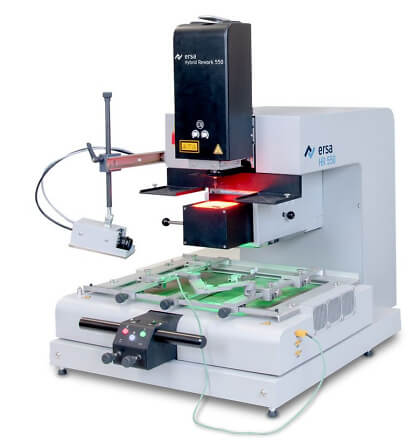
![190924 Ersa HR 550 XL mit Leiterplatte B 2767 web 80558 [JPEG Web (RGB)]](/upload/rm/190924-ersa-hr-550-xl-mit-leiterplatte-b-2767-web--3.jpg?_=1604992800000)
![0HR600 2 Hybrid Rework System 2 web 2911 [JPEG Web (RGB)]](/upload/rm/0hr600-2-hybrid-rework-system-2-web-2911-jpeg-web--3.jpg?_=1604992800000)
![0HR600XL Hybrid Rework System DSC 2354 web 4602 [JPEG Web (RGB)]](/upload/rm/0hr600xl-hybrid-rework-system-dsc-2354-web-4602-jp-1.jpg?_=1604992804000)
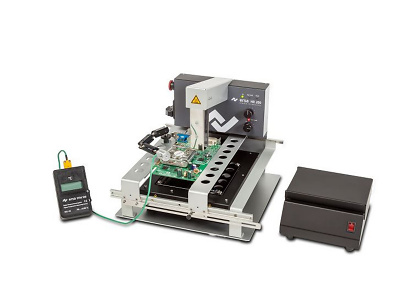
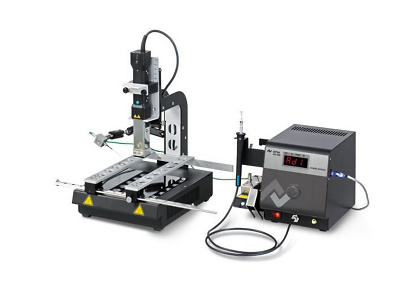
![0HR510 1070458 web 2578 [JPEG Web (RGB)]](/upload/rm/0hr510-1070458-web-2578-jpeg-web-rgb-7.jpg?_=1604992804000)
![0PR100 1 web 3809 [JPEG Web (RGB)]](/upload/rm/0pr100-1-web-3809-jpeg-web-rgb-1.jpg?_=1604992803000)
